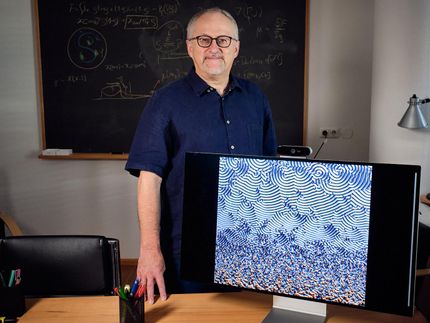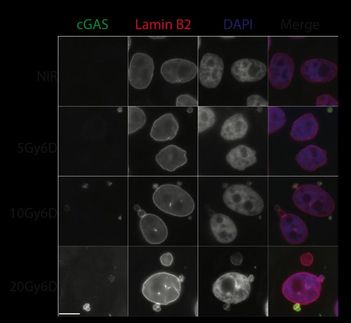Smart interaction between proteins
Advertisement
Very little was known till now about DNA repair by homologous recombination, which is fundamental for human health. Now an ETH research group has for the first time isolated and studied all the key proteins involved in this process, laying the foundation for investigating many diseases.

Which proteins are essential for cell division? The biochemist Philipp Wild (left) and his colleagues Ilaria Piazza and Christian Dörig examine the results from the mass spectrometer.
ETH Zürich / Adrian Henggeler
Within our body, the process of cell division is constantly creating new cells to replace old or damaged ones. The genetic information is also duplicated and passed on to the new cells. Complex interaction of many different proteins ensures a smooth process. This is because these proteins immediately repair any errors that creep in during DNA duplication. However, the same protein machinery also performs another function: in germ cells that divide to from gametes – egg cells and sperm – it is responsible for mixing the genetic information of the original maternal and paternal side during cell division. The same mechanism therefore has to resolve two conflicting problems: in normal cell division, called mitosis, it ensures genetic preservation, while in the cell division to produce gametes, or meiosis, it ensures genetic diversity.
Both tasks are vital. If DNA repair does not work in mitosis, this can lead to cancer and other diseases. If, on the other hand, the exchange of DNA in meiosis does not function correctly, the fertility and health of the offspring may be damaged. “Although these processes are crucial for our health, very little was known till now about how the whole system functions and is regulated,” says Joao Matos, Professor for Biochemistry at ETH Zurich. His team has now studied the responsible proteins and discovered how they differentiate between the two tasks.
A complex task
The scientists began by cultivating a large number of yeast cells in the laboratory, as these cells only contain a minute quantity of the proteins involved. The production of the yeast cells was therefore extremely complex: the researchers cultivated cells in 120 6-litre containers in such a way that the division occurred simultaneously in all yeast cells. Mitosis and meiosis are highly complex processes that take place in precisely orchestrated phases. Only synchronised cell cultures can thus differentiate which proteins are important in which phase, and how they work together.
Scientists already knew that yeast, along with plants, animals and humans, have a group of seven enzymes involved in the reproduction of DNA: the recombination intermediates processing enzymes (RIPEs). For the first time, ETH scientists were able to isolate these RIPEs from the cell cultures and identify them in the mass spectrometer – from a specific phase of cell division in each instance. At the same time, they used this method to identify a series of other proteins that help regulate cell division.
The same components, but rewired
Joao Matos and his team were eventually able to identify which RIPEs are important for which phase of cell division and which helper proteins interact with the RIPEs in each case. The first unexpected result: the quantity of RIPEs remains almost constant in all phases of mitosis and meiosis. “Unlike many other processes, the cells do not regulate cell division and DNA repair through the production of the proteins involved,” Matos explains. Instead, the helper proteins interact systematically with the RIPE enzymes in order to enable or disable them in a specific phase. “All the components are always there, but are rewired depending on the task”, says the ETH professor.
For example, the researchers discovered that three of the RIPEs lose almost all their interaction partners precisely in the so-called metaphase of meiosis, in other words when the maternal and paternal DNA is mixed. In return, another protein complex is formed at this point. “This must be responsible for mixing up the maternal and paternal DNA,” Matos concludes. In addition, ETH researchers have identified a number of new helper proteins whose role was previously unknown.
Key to understanding disease
The results from the yeast cells can be transferred to humans, as for every helper protein involved there is an equivalent in humans that functions in the same or very similar fashion. So the Matos research group and fellow scientists can build on this knowledge. They can now study specific proteins to discover whether, and how, they are involved in the development of diseases and ultimately find a remedy to combat them.

























































